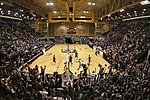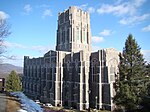Michie Stadium
1924 establishments in New York (state)American football venues in New York (state)Army Black Knights footballArmy Black Knights men's lacrosseCollege football venues ... and 4 more
College lacrosse venues in the United StatesLacrosse venues in New York (state)Sports venues completed in 1924Sports venues in Orange County, New York

Michie Stadium is an outdoor football stadium on the campus of the U.S. Military Academy in West Point, New York. The home field for the Army Black Knights, it opened 98 years ago in 1924 and has a current seating capacity of 38,000.The stadium sits at the upper portion of campus, directly west of Lusk Reservoir. The field is at an elevation of 335 feet (102 m) above sea level and runs in the traditional north–south configuration, with the press box above the west sideline. Due to the view offered by its location overlooking the Hudson River and the Neo-Gothic architecture of the campus below, it was rated as Sports Illustrated's #3 sports venue of the 20th century.
Excerpt from the Wikipedia article Michie Stadium (License: CC BY-SA 3.0, Authors, Images).Michie Stadium
Stony Lonesome Road,
Geographical coordinates (GPS) Address External links Nearby Places Show on map
Geographical coordinates (GPS)
| Latitude | Longitude |
|---|---|
| N 41.3875 ° | E -73.964166666667 ° |
Address
Michie Stadium
Stony Lonesome Road
10996
New York, United States
Open on Google Maps









